Martian Parrot
I did not want to touch on this topic separately, but the wave went too far to ignore it, even this infection got to the hub. On Twitter, the hash tag has already appeared #CuriosityFindings. Yes, I’m again about the same statement by John Grotzinger about the results of the analysis of the SAM device on board Curiosity. Just try to figure out why this whole story deserves the epithet "parrot" (parroting - chatter like a parrot) in the words of a representative of the NASA press service.
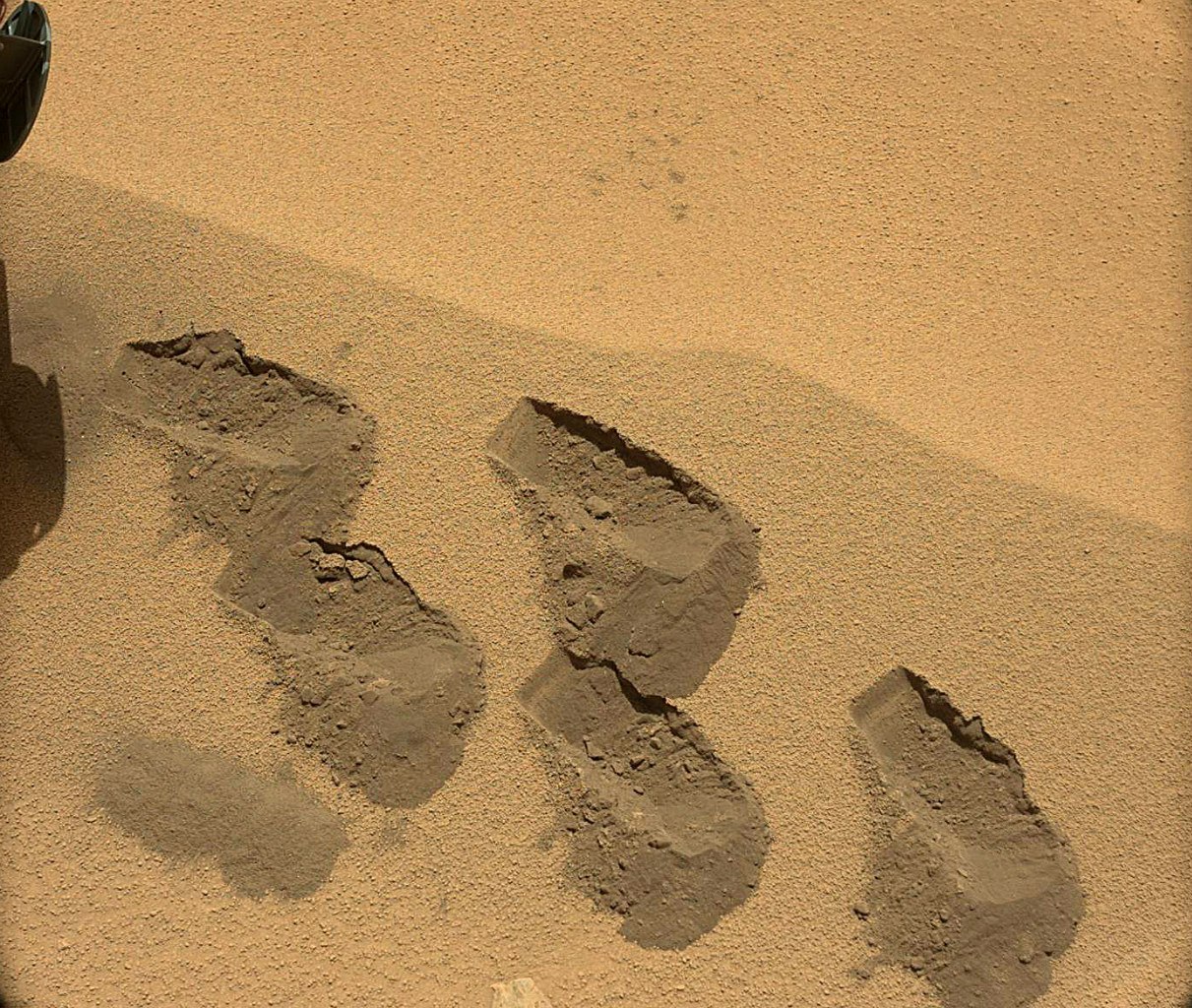
To get started on the SAM (Sample Analysis at Mars). I wanted to tell you more about him when his first results become known, but our media do not give such an opportunity, so a brief overview.

SAM is three instruments in one: quadrupole mass spectrometer, gas chromatograph, and tunable laser spectrometer. The device conducts a study of gaseous media. He heats solid samples in a quartz furnace, turning it into a gaseous form. Gaseous substances can pass through each device individually, or through all three at once. This allows not only to accurately determine the chemical composition of the test sample, but also to measure the atomic mass of substances, that is, to isolate isotopes and separate, for example, ¹²C from ¹³C in air, deuterium from hydrogen in water, etc. The determination of the gas content in the test sample reaches several parts per billion.
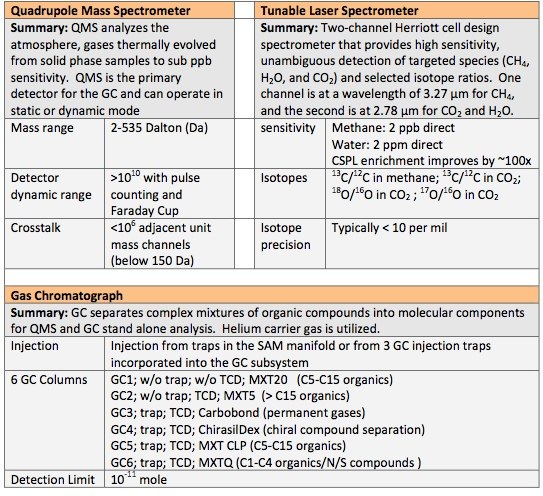
In addition to the good quality of analysis, the device itself is unique in that it is located on Mars. It is similar to a telescope for Galileo or a microscope for Levenguk - it doesn’t matter whether it is qualitative or not, but any application of it will lead to discoveries and, probably, sensational.
In late October, SAM had already conducted a study of the atmosphere. Moreover, the analysis had to be carried out twice - the first samples of Martian air were mixed with the one that the rover brought from Cape Canaveral. The second test was already purely Martian.
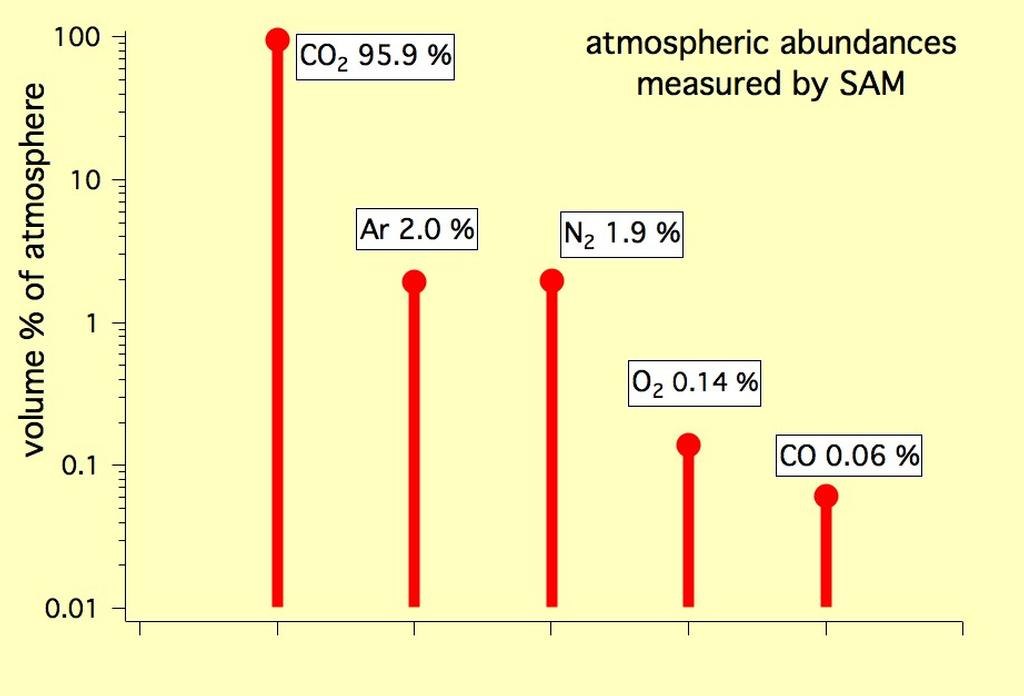
She gave some new information about the evolution of the atmosphere. In particular, an increased content of heavy isotopes of carbon and argon was recorded - this suggests that, due to the influence of the solar wind, primarily light forms of gases escape into space.
In addition, the rover tried to determine the methane content in the atmosphere and did not find it. Methane emissions into the atmosphere were determined from satellites and even ground-based telescopes. Scientists were particularly interested in the fact that the accumulation of this gas was very local, and it quickly disappeared.
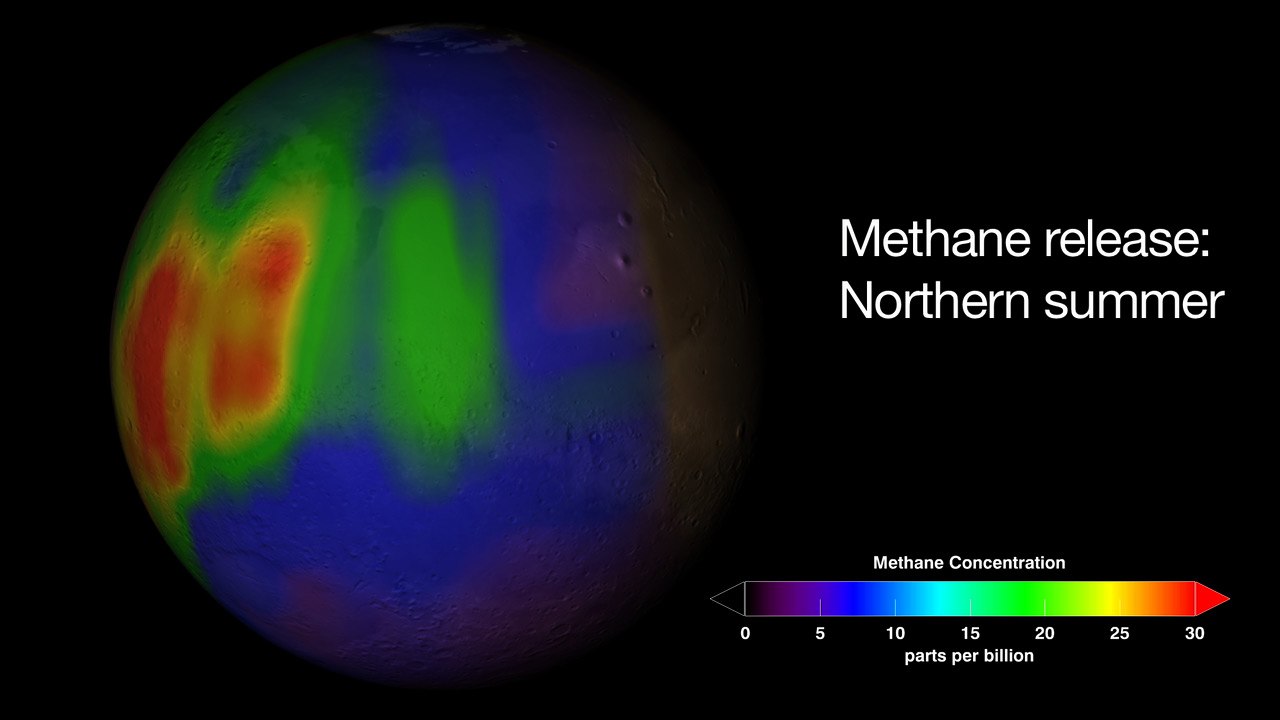
Methane is an organic gas that is formed on Earth most often as a result of the activity of bacteria. Therefore, this observation was very intriguing to scientists and optimists who hope for at least the microbial habitability of Mars. At the same time, several models were developed in which methane is formed in a natural way: due to tectonic activity (which is also good because it is now believed that the planet is tectonically dead); due to ultraviolet irradiation of ice cover; due to the fall of meteorites and due to electrical discharges arising in dusty tornadoes over the same ice sheets. Curiosity was supposed to clarify the situation, but he decided it using the Stalinist method: "no gas - no problem." However, the appearance of methane is a seasonal event and the Curious will still have a chance.
After air, it was the turn of the soil.
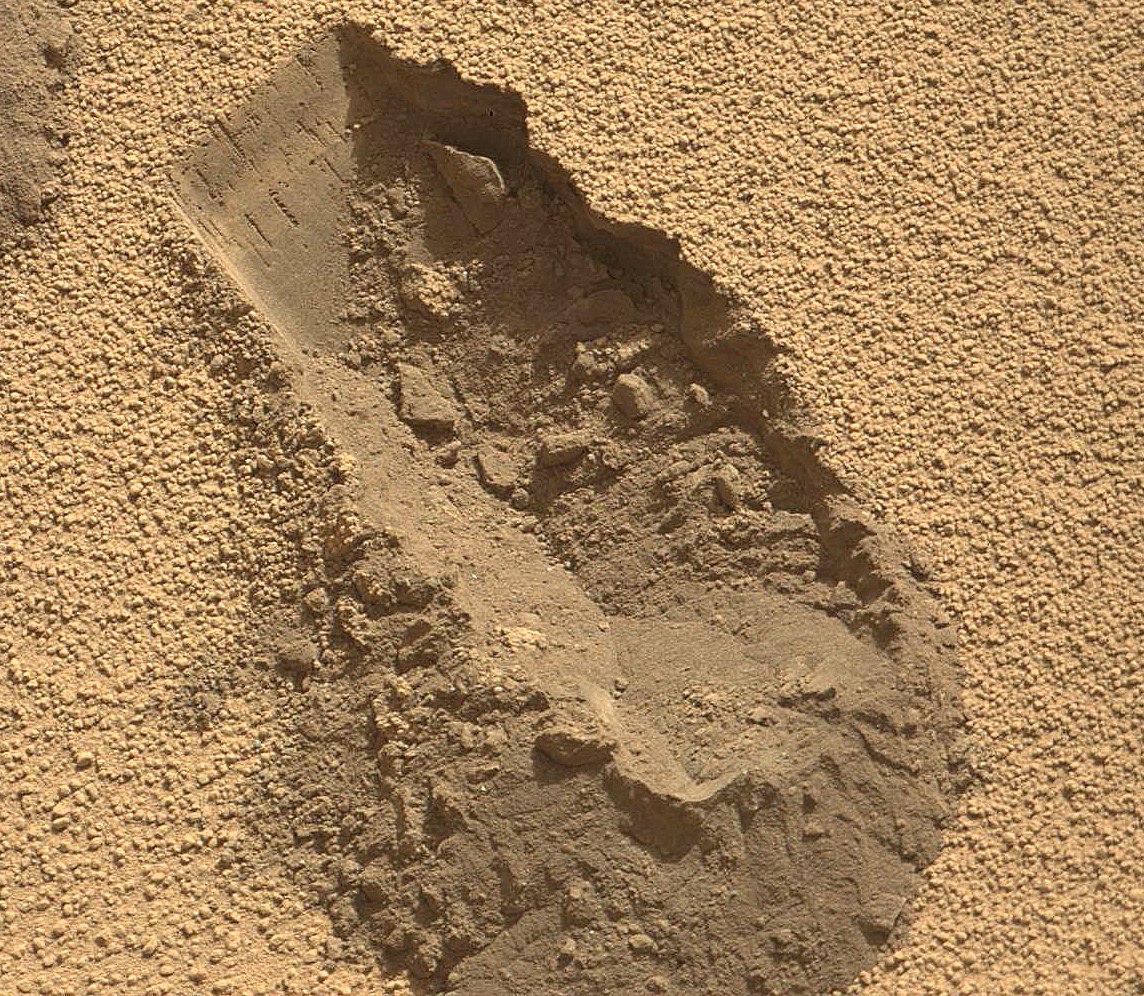
In order to better understand what scientists could find on Mars, it is necessary to consider what they studied. Curiosity spent 57 to 102 sols at a place called Rocknest - a “rock nest."
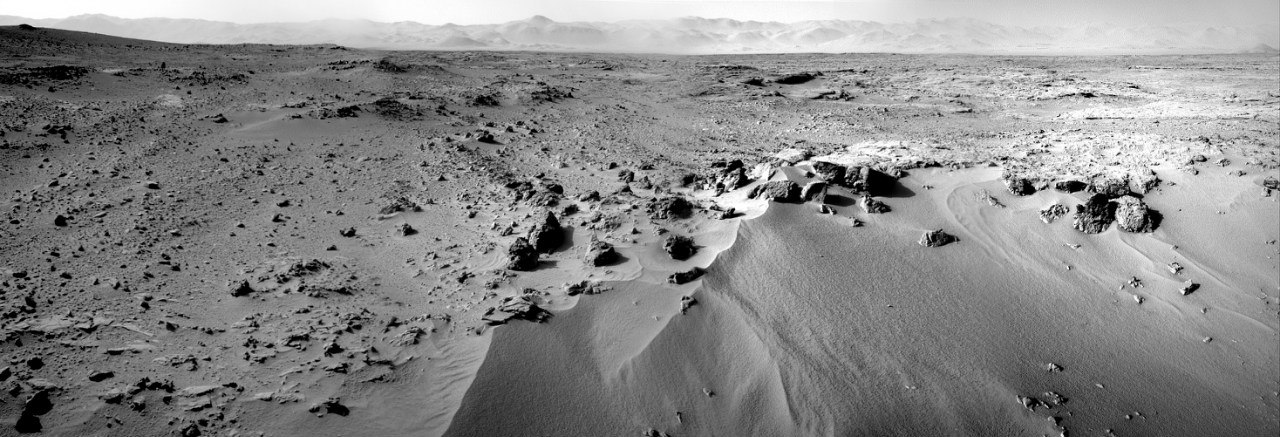
During this time, he used almost all of his scientific tools on the "nest". SAM tests were carried out in the last week and after that the rover left there. At the moment, he has moved about 26 meters and crawled closer to the shore of the proposed reservoir.
Rocknest is a sand spit that could literally be replaced in a previous dust storm. That is, it is not even root soil. Curiosity scooped up from above, deepening about 5 centimeters. It turns out that this is literally superficial research.
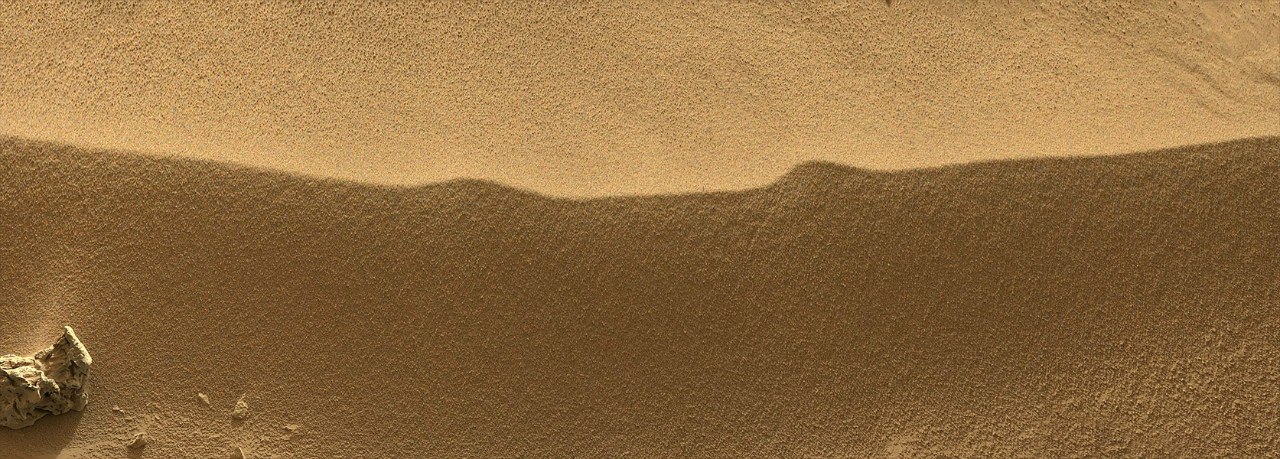
Prior to SAM analysis, this sand was examined by ChemCam, APXS, and, most importantly, CheMin spectrographs. The latter is also an outstanding device located in the body of the rover. It determines the crystal lattice of minerals and their chemical structure by X-ray spectrography and diffraction.

And according to the results of this analysis, it was concluded that the sand is of volcanic origin. NASA even attached a photograph of the foot of the Hawaiian volcano to make it clear what kind of ground they were exploring. Even on Earth, it will be difficult to find organic matter in this soil.

The fact that Curiosity did not find either life or oil can be understood at least by his actions. He had nowhere to rush, he stood for 40 days at a heap of sand, so there was no sense in breaking somewhere. If they found something really interesting, they would dig another two months. Energy is still enough for 14 years.
NASA has more than once fallen into trouble with hasty statements about life discovered on Mars. Therefore, they would check the samples 5 more times to be 100% sure. And they “found something interesting, worthy of a history textbook” and rolled on.

(twitter tweet from twitter.com/MSL_Curiosity )
True, they still have a supply of this sand with them in the CHIMRA device on the manipulator, but so far they are in no hurry to conduct additional research - everything seems clear to them.
This story will definitely fall into the textbooks, but not geology, but PR. As one careless word of a scientist, hundreds of media can catch up and inflate a one-day global sensation. So, NASA officials had to explain and comment on these words:

Bob Jacobs, deputy assistant administrator of the NASA Communications Department: “Everyone is talking like parrots about @ MarsCuriosity. “Worthy of a history book” refers to the mission as a whole, and not to any new discovery. ”
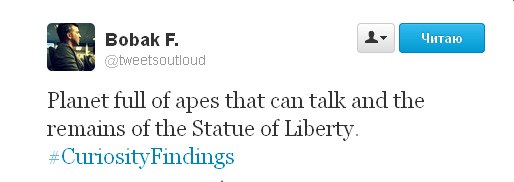
MSL Curiosity Flight Manager Bobak Firdousi:
“A planet full of talking monkeys and the ruins of the Statue of Liberty”
In any case, we will know the results when they are announced at the American Geophysical Union’s fall meeting on December 3-7 in San Francisco. But it will be neither bacteria, nor oil, nor coal. Most likely, not even the hydrocarbon precursors of life that this device can determine. Some sensation understandable to a bunch of geeks from geology and chemistry.
They will also tell you about the updated results of radiation monitoring over 90 days, this is also interesting: it directly affects the prospects of a manned mission.
UPD: Thanks for clarifying the translation of Singerofthefall tweets

To get started on the SAM (Sample Analysis at Mars). I wanted to tell you more about him when his first results become known, but our media do not give such an opportunity, so a brief overview.

SAM is three instruments in one: quadrupole mass spectrometer, gas chromatograph, and tunable laser spectrometer. The device conducts a study of gaseous media. He heats solid samples in a quartz furnace, turning it into a gaseous form. Gaseous substances can pass through each device individually, or through all three at once. This allows not only to accurately determine the chemical composition of the test sample, but also to measure the atomic mass of substances, that is, to isolate isotopes and separate, for example, ¹²C from ¹³C in air, deuterium from hydrogen in water, etc. The determination of the gas content in the test sample reaches several parts per billion.

In addition to the good quality of analysis, the device itself is unique in that it is located on Mars. It is similar to a telescope for Galileo or a microscope for Levenguk - it doesn’t matter whether it is qualitative or not, but any application of it will lead to discoveries and, probably, sensational.
In late October, SAM had already conducted a study of the atmosphere. Moreover, the analysis had to be carried out twice - the first samples of Martian air were mixed with the one that the rover brought from Cape Canaveral. The second test was already purely Martian.

She gave some new information about the evolution of the atmosphere. In particular, an increased content of heavy isotopes of carbon and argon was recorded - this suggests that, due to the influence of the solar wind, primarily light forms of gases escape into space.
In addition, the rover tried to determine the methane content in the atmosphere and did not find it. Methane emissions into the atmosphere were determined from satellites and even ground-based telescopes. Scientists were particularly interested in the fact that the accumulation of this gas was very local, and it quickly disappeared.

Methane is an organic gas that is formed on Earth most often as a result of the activity of bacteria. Therefore, this observation was very intriguing to scientists and optimists who hope for at least the microbial habitability of Mars. At the same time, several models were developed in which methane is formed in a natural way: due to tectonic activity (which is also good because it is now believed that the planet is tectonically dead); due to ultraviolet irradiation of ice cover; due to the fall of meteorites and due to electrical discharges arising in dusty tornadoes over the same ice sheets. Curiosity was supposed to clarify the situation, but he decided it using the Stalinist method: "no gas - no problem." However, the appearance of methane is a seasonal event and the Curious will still have a chance.
After air, it was the turn of the soil.

In order to better understand what scientists could find on Mars, it is necessary to consider what they studied. Curiosity spent 57 to 102 sols at a place called Rocknest - a “rock nest."

During this time, he used almost all of his scientific tools on the "nest". SAM tests were carried out in the last week and after that the rover left there. At the moment, he has moved about 26 meters and crawled closer to the shore of the proposed reservoir.
Rocknest is a sand spit that could literally be replaced in a previous dust storm. That is, it is not even root soil. Curiosity scooped up from above, deepening about 5 centimeters. It turns out that this is literally superficial research.

Prior to SAM analysis, this sand was examined by ChemCam, APXS, and, most importantly, CheMin spectrographs. The latter is also an outstanding device located in the body of the rover. It determines the crystal lattice of minerals and their chemical structure by X-ray spectrography and diffraction.

And according to the results of this analysis, it was concluded that the sand is of volcanic origin. NASA even attached a photograph of the foot of the Hawaiian volcano to make it clear what kind of ground they were exploring. Even on Earth, it will be difficult to find organic matter in this soil.

The fact that Curiosity did not find either life or oil can be understood at least by his actions. He had nowhere to rush, he stood for 40 days at a heap of sand, so there was no sense in breaking somewhere. If they found something really interesting, they would dig another two months. Energy is still enough for 14 years.
NASA has more than once fallen into trouble with hasty statements about life discovered on Mars. Therefore, they would check the samples 5 more times to be 100% sure. And they “found something interesting, worthy of a history textbook” and rolled on.

(twitter tweet from twitter.com/MSL_Curiosity )
True, they still have a supply of this sand with them in the CHIMRA device on the manipulator, but so far they are in no hurry to conduct additional research - everything seems clear to them.
This story will definitely fall into the textbooks, but not geology, but PR. As one careless word of a scientist, hundreds of media can catch up and inflate a one-day global sensation. So, NASA officials had to explain and comment on these words:

Bob Jacobs, deputy assistant administrator of the NASA Communications Department: “Everyone is talking like parrots about @ MarsCuriosity. “Worthy of a history book” refers to the mission as a whole, and not to any new discovery. ”

MSL Curiosity Flight Manager Bobak Firdousi:
“A planet full of talking monkeys and the ruins of the Statue of Liberty”
In any case, we will know the results when they are announced at the American Geophysical Union’s fall meeting on December 3-7 in San Francisco. But it will be neither bacteria, nor oil, nor coal. Most likely, not even the hydrocarbon precursors of life that this device can determine. Some sensation understandable to a bunch of geeks from geology and chemistry.
They will also tell you about the updated results of radiation monitoring over 90 days, this is also interesting: it directly affects the prospects of a manned mission.
UPD: Thanks for clarifying the translation of Singerofthefall tweets
